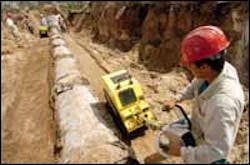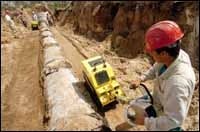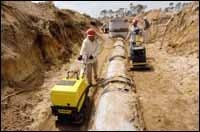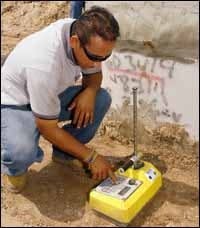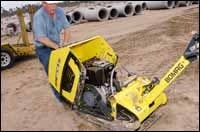Bomag Compactors Outperform Predecessors
Want some advice? If ever you're working on a jobsite that has both the old and new versions of Bomag's reversible-plate compactors, then get up early, beat it to the site and get your hands on a new one. Dare we suggest that you not even take time for a coffee stop?
Recently, on a Florida jobsite, we had the chance to run two of Bomag's three new reversible-plate models, along with their predecessor models, and we'd want first dibs on a new model if we were running these machines on a regular basis. We hasten to add that the old models are in no way objectionable; it's just that the new ones are that much better.
What got our attention initially about the new Bomags — when we ran them in late March at a DiVosta Homes' development in West Palm Beach — was the reduced vibration that they transmit through the handle and into your hands and arms. Bomag developed a new four-point, vibration-isolation system for the handle mounting, and we can attest that it's effective.
We also took note of their increased power. These new Bomags move more briskly across flat surfaces and have considerably more strength when asked to negotiate inclines. We didn't get the machines in quite as steep an attitude as did our Bomag host, Peter Price, but steep enough to sense the difference between old and new. And the new plates are quieter — much quieter — mostly the result of a new housing that completely encloses the engine compartment.
Bomag's Price, manager of product and training for the company's Light Equipment and Rental Division, arranged through manufacturers' representative David Megathlin, who works for Lew Hudson Sales, to have a new BPR-45/55-D and BPR-65/70-D shipped to Florida from the Conexpo-Con/Agg 2005 show floor. Megathlin worked with Todd Taylor, president, and Michelle Dalton, sales, at All-Star Equipment, a rental/sales/service company in West Palm Beach, to get the machines on a jobsite where the contractor was already using the old counterpart models — the BPR-40/45-D-3 and BPR-65/52-D-3.
Dalton asked Pipeline Utilities, a water-and-sewer contractor based in Riviera Beach, to give the new reversible plates a try, alongside some of its own 15 older-model Bomag plates. Our thanks to Michelle for her efforts; and to Pipeline Utilities' David Craddock, president; Alan Shearin, field superintendent; and Ron Johnson, project manager, for their gracious assistance.
Several years ago, says Price, Bomag came to the rather unsettling conclusion that its reversible plates were no longer "state-of-the-art." In a way, he says, the Bomag reversible plate was the victim of its own success. Because the machines worked well in granular materials (soils containing sand or gravel), he says, contractors began using them in cohesive materials (silt and clay) and in soils with high moisture content — applications for which the machines were not specifically designed.
"Granular materials respond well to vibratory compaction," says Price, "because the action reduces friction between soil particles and allows them to rearrange into a more-dense mass. Cohesive materials, though, respond better to impact-type compaction, which forces out trapped water and air."
Although Bomag reversible plates continued to yield good compaction results in conditions that did not suit their basic design, says Price, their travel speed slowed appreciably in these applications. Slow machines, he says, are equated with unproductive machines. While that reasoning may not be particularly justified in the world of compaction, Bomag realized the potential consequences of the perception and started redesigning.
The engineering challenge was complicated: Design the reversible plate to be even more effective at compacting a range of soils, including cohesive types and those with high moisture, yet meet user expectations for travel speed and gradeability (hill-climbing capability).
The company launched this engineering effort in a practical manner, says Price, by visiting jobsites across North America to better understand both how reversible plates were actually being applied, and how they performed in adverse materials. The result of this research, he says, was a new finite-element-analysis program that was instrumental in guiding engineering parameters and testing.
At the heart of the new design is a fresh approach to base-plate (compacting surface) geometry and to exciter (vibratory mechanism) performance. In Bomag's words, the engineering goal was "to optimize weight, and optimize amplitudes (vibration height) with frequencies (vibration rate)." An integral aspect of achieving this basic aim was to give each of the three new models more horsepower. And Bomag did not skimp in this regard.
The biggest power increase (nearly 50 percent) was for the smallest model, the BPR-45/55-D, which uses an 8.8-hp Lombardini diesel in place of its predecessor's 5.9-hp Yanmar. (A 9-hp Honda gas engine is optional.) The mid-size BPR-55/65-D, which uses the same 8.8-hp Lombardini as its smaller counterpart, is up 13 percent in power from its predecessor's 7.8-hp Hatz diesel. And the largest machine, the BPR-65/70-D, is fitted with a 13.3-hp Hatz diesel — a 33-percent increase in power over its predecessor's 10-hp Hatz.
The added horsepower, says Bomag, "allows for higher performance, be it gradeability, travel behavior or energy output." Plus, says the company, the reserve power built into these engines should extend the overall life of the machine.
While base-plate configuration, exciter optimization and more powerful engines made up the primary design focus for the new reversible-plate models, the overall package included numerous other refinements.
Already noted, for instance, is the four-point handle-mounting system that reduces transmitted vibration. But as an added benefit, says Bomag, the new mounting system also provides a degree of flexibility between handle and machine, allowing the handle to take a hit on the jobsite without much consequence.
Also, the guide handle (at the top of handle column) is now stationary on the two smaller new models and has a separate directional-control lever. This contrasts with the moveable, all-in-one handle on predecessor models. The new directional-control system is simpler in design, as well, because if the control lever takes an accidental hit, an inexpensive and easily replaced split (shear) pin gives way, and thus protects the exciter's reversing mechanism from hydraulic-oil pressure spikes. On former models, with the directional-control mechanism integral with the guide handle, a pressure-relief valve was required to afford the needed protection.
We read with a smile this line from Bomag literature about its new reversible plates: "Diesel plates, like light compaction equipment in general, do not receive the care and maintenance of larger, more-expensive equipment." In other words, little stuff gets little respect, especially when it's rented little stuff.
To Bomag's credit, it designed its new machines around this reality by equipping them with some protective armor. Probably the most distinctive feature of the new models, in fact, is their full engine cover, compared with the former models' open engine compartment with a sheet-metal hood and front and rear rollbars. The cover, besides having thick rubber shields bolted on the front and sides, is made of "fine-grain" steel.
Fine-grain steel has grains (crystals that form the steel) that may be only one-third the size of those of conventional steel alloys. Fine-grain steel is the result, basically, of special rolling and cooling processes at the mill. The payoff is a material with extremely high tensile strength, high fatigue limits and exceptional resistance to impact.
We cringed when Bomag's Price asked the operator of a big Komatsu PC600LC hydraulic excavator on site to swing the machine's 5-cubic-yard bucket into the cover of one of the new reversible plates. The operator, understandably, was disbelieving at first, but at Price's insistence, gave the plate a tap. "Harder," said Price, so the operator gave it a pretty good smack. The only damage was a bit of scuffed paint — no dings, no creases, no deformation. We were impressed.
But for all of its protection, the new models are relatively easy to service. Two thick rubber flaps, one on top of the cover, the other on the rear, lift up to provide roomy access to all routine maintenance points, and external oil drains for the engine and exciter housings simplify changes. For complete access to the engine, clutch, drive belt and exciter assembly, the cover tilts forward nearly 90 degrees.
After spending a day with Bomag's new reversible plates, we're certain the company did its homework when developing these new machines. We can't speak specifically for the new models' compaction effectiveness, compared to their predecessor models, nor can we speak to their ability to work at practical speeds in all soil conditions. But we can say this: As we observed Bomag's Price working an old machine, then a new one, through a sloppy, wet area at the site, we'd get up early and skip coffee to run the new one.
